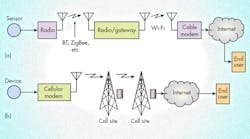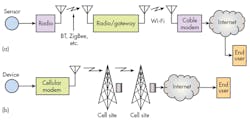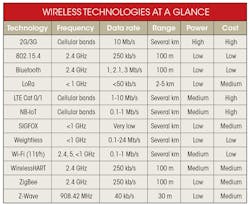This file type includes high-resolution graphics and schematics when applicable.
The Internet of Things (IoT) is a massive collection of sensors, actuators, and/or devices either connected to one another or to some master control or monitoring point via the internet. Multiple communications links are used to make the connection.
However, the device itself usually connects to the system by radio. This wireless connection is the critical or weakest link in the system. Therefore, it’s essential that you select a wireless method that matches the device and its surrounding environment. Literally dozens of wireless technologies and standards are available to choose from—this article guides you through the most likely wireless candidates for new designs.
A typical IoT connection scenario involves the device linking to a gateway via wireless (see figure). The gateway is the interface to the internet via a common broadband cable or DSL modem, and then on to the internet service provider for connection to the Internet. In an alternative scenario, otherwise known as M2M, the device connection goes through a cellular carrier and then to another carrier or on to the internet.
The diagram shows typical wireless-connection scenarios for IoT (a) and M2M (b).
A number of design factors must be scrutinized when selecting a wireless technology:
• Data rate of the device: Streaming video, measuring temperature every minute, or something in between.
• Range or distance to the gateway: A few feet within a room or over a mile in a rural area.
• The environment: Hazardous surroundings in a factory, outdoors in the weather, noise from electrical equipment or EMI, etc.
• Need for encryption or authentication: What is the demand for data security?
• Power consumption: Battery life; energy efficiency; possible need for an ac mains connection.
• Capacity: Number of connected devices.
• Quality of service and reliability.
• Network topology: Star, mesh, or other.
• Simplex or duplex: One-way vs. two-way communications.
• Suitable and available spectrum: Licensed or unlicensed.
• Available ICs, modules, and equipment.
• Cost: Design, manufacturing, or Internet access service expense.
• Development platform: Is an OS needed? What other software is required?
• Internet access: Cellular, DSL, cable, satellite.
• Licensing conditions of standards available.
2G/3G Cellular
Yes, cellular networks can be used for IoT applications. Generally known as machine-to-machine (M2M), many of its use cases are nonetheless similar to IoT. Multiple vendors offer cell-phone modules to embed into other products, and most of the major cellular carriers provide M2M connection services over standard licensed spectrum. Though 2G technology like GSM/GPRS/EDGE is popular, some carriers already have plans to phase-out 2G capability.
However, most networks still support 3G technologies like WCDMA and cdma2000 with data rates up to several megabits per second. Range is the distance to a cell site, and can be up to several kilometers. Cellular connectivity is clearly an option, although more expensive than some alternatives like the low-power wide-area-network (LPWAN) technologies described later.
This is the popular wireless standard developed by the Institute of Electrical and Electronic Engineers (IEEE). Targeting short-range, low- to medium-data-rate and low-power-consumption use cases, it’s the basis for several other standards listed later. Its main operating spectrum is the 2.4-GHz industrial, scientific and medical (ISM) license-free band. The 902- to 928-MHz and 868-MHz bands are in play, too.
Modulation is direct sequence spread spectrum (DSSS) with differential binary phase-shfit keying (BPSK) or offset quadrature phase-shift keying (QPSK). Operating at a 1 mW (0 dBm), it offers a data rate of 250 kb/s in the 2.4-GHz band. Range is 10 to 100 meters using a point-to-point or star topology. Access is carrier sense multiple access with carrier avoidance (CSMA/CA) for up to 216 nodes; more nodes are possible with 6LoWPAN (see “6LoWPAN Addresses Nodes”" below). It employs AES-128 encryption for security purposes.
The 802.15.4 standard provides the PHY and MAC networking layers with a packet-based protocol. Other standards use this as the basis for adding more layers, providing enhanced networking features and capabilities.
6LoWPAN Addresses Nodes
The Internet Engineering Task Force’s (IETF) 6LoWPAN is shorthand for Internet Protocol 6 (IPv6) over Low Power Wireless Personal Area Networks. The standard allows IPv6 to give IoT nodes a standard IP address. It’s designed to be used with other wireless standards.
Originally aimed at 802.15.4, the standard also has been adopted by Bluetooth Smart and low-power HaLow Wi-Fi. Specifically, 6LoWPAN defines ways to use encapsulation and header compression techniques to fit IPv6 packets into the frames of other protocols.
Perhaps the most widely used short-range wireless technology is Bluetooth (BT), which operates in the 2.4-GHz ISM band. Several different versions offer multiple data rates, power levels, and range potentials. The basic operating principle is frequency-hopping spread spectrum (FHSS) with different modulation methods. Gaussian frequency-shift keying (GFSK) is the main modulation method, providing a 1-Mb/s data rate. Data rates of 2.1 or 3 Mb/s can be achieved using higher modulation rates. Power levels to 100 mW boost its range up to 100 meters.
The newest version of Bluetooth is BT Smart or version 4.1. Also called Bluetooth Low Energy (BLE), the configuration uses shortened packets, a maximum rate of 1 Mb/s, and GFSK modulation. Its primary benefit is super low power consumption. Transmit power is 10 mW, and its range can extend up to 100 meters. Multiple software profiles are available for different uses, and an interoperability certification is in effect to ensure full compatibility.
LoRa (long range), a technology created by Semtech, has typical operating frequencies of 915 MHz for the U.S., 868 MHz for Europe, and 433 MHz for Asia. The LoRa physical layer (PHY) uses a unique form of FM chirp spread spectrum along with forward error correction (FEC). This spread-spectrum modulation permits multiple radios to use the same band if each radio employs a different chirp and data rate. Typical range is 2 to 5 km, and up to 15 km is possible depending on the location and antenna characteristics.
LTE stands for Long Term Evolution, the current 4th-generation cellular technology. The standard, which is the creation of the 3GPP and ITU, is widely implemented in the U.S. and around the world. It’s perhaps best known for its high-speed capability of up to 300-Mb/s downlink using higher-level QAM and MIMO.
LTE Cat 0 and Cat 1 are reduced-function versions of LTE designed for low power and low speed to match the needs of M2M. M2M applications, also called machine-type communications (MTC), use the existing cellular network in licensed spectrum rather than short-range wireless and the internet.
The standard LTE network is overkill for most basic monitoring and control uses. LTE Cat 0 and Cat 1 are simplified versions that can provide solutions for M2M applications with maximum data rates of 1 Mb/s and 10 Mb/s, respectively. Cat 0 and Cat 1 use the existing LTE bandwidths with orthogonal frequency-division multiple-access (OFDMA) modulation. This long-range solution is capable of kilometers of distance.
A relatively recent variation of using LTE for IoT is NarrowBand IoT. Instead of using the full 10- or 20-MHz bandwidth of standard LTE, NB-IoT uses a 180-kHz-wide resource block of 12 15-kHz LTE subcarriers. Data rates will be in the 100-kb/s to 1-Mb/s range.
This more simplified standard provides very low power consumption for connected devices. Furthermore, it can be deployed in any LTE network as a software overlay. A resource block of NB-IoT fits nicely inside a standard LTE channel or within a guard band. It also fits into a standard GSM channel as carriers re-farm their older 2G spectrum. Modulation is OFDMA downlink and SC-FDMA uplink. NB-IoT offers another competitive long-range solution.
SIGFOX is a wireless technology as well as a network service. The name derives from a French company that offers its wireless technology as well as a local LPWAN for longer-range IoT or M2M applications. It operates in the 868- and 902-MHz ISM bands, but consumes very little bandwidth or power.
SIGFOX radios, which exploit a technique called ultra-narrowband (UNB) modulation, only transmit short messages at low data rates occasionally. Messages can be up to 12 bytes long, and a node can send up to 140 messages per day. Because of the narrow bandwidth and short messages, in addition to its 162-dB link budget, long range up to several kilometers is possible. Networks with forwarding base stations have been established in Western Europe and the San Francisco area.
Weightless is a family of open wireless-technology standards targeting IoT applications. Three different versions address different segments of the LPWAN marketplace.
The simplest version is Weightless-N for low-cost applications. This version targets simplex or one-way uses such as sensor monitoring. It operates in the sub-1-gigabit license-free ISM. Modulation is differential BPSK using a frequency-hopping technique to minimize interference. A key feature is its 128-bit AES encryption with full authentication. With low data rates and narrow channels, a range up to 5 km is possible. Up to 10 years of battery life is possible thanks to the standard’s low power consumption.
If higher performance with two-way communication is needed, Weightless-P might be the best option. It uses a combination of frequency-division multiple access (FDMA) and time-division multiple access (TDMA) to manage access to multiple 12.5-kHz-wide channels. Data rates can range from a low of 200 b/s to 100 kb/s using GMSK and offset QPSK modulation. Typical maximum range is about 2 km. Both AES-128/256 encryption and authentication are used for security.
The third version, Weightless-W, is designed to operate in the TV white spaces. White spaces are those 6-MHz-wide channels previously used by TV stations in the 470 to 790 MHz space. It is possible to achieve data rates from 1 kb/s to 10 Mb/s, depending on the link budget. A range of 5 km or more is possible in non-line-of-sight situations. Use of TV white spaces requires the base stations to reference a master database of TV bands and wireless microphone frequencies and subsequently choose an unused band to avoid interference. Weightless is a royalty-free IP that helps minimize cost.
Wi-Fi is employed in many IoT use cases, most commonly as the link from the gateway to the router with the connection to the internet. However, it does find a place in the main wireless link, which requires high speed and medium range. A good example is video monitoring in the home or in a commercial/industrial setting for security.
Most versions of Wi-Fi operate in the 2.4-GHz unlicensed band and have a range of up to 100 meters depending on the environment. The popular 802.11n can handle speeds to 300 Mb/s, while the more recent 802.11ac, which operates in the 5-GHz ISM band, reaches speeds in excess of 1.3 Gb/s.
A new IoT-friendly version of Wi-Fi called HaLow is coming soon. Designated 802.11ah, it uses the 902- to 928-MHz license-free band in the U.S. and similar bands just below 1 GHz in other countries. This is good news, as low power can be used over these lower frequencies, thus enabling battery-operated equipment. While most Wi-Fi gear has a maximum range of 100 meters under ideal conditions, HaLow can reach up to a kilometer with the right antenna.
Modulation for 11ah is OFDM using 24 subcarriers in a 1-MHz channel and 52 subcarriers in the larger bandwidths. It can be BPSK, QPSK, or QAM, providing for a wide range of data rates. Rates of 100 kb/s to several megabits per second will suffice in most cases—the real goal was low power. The Wi-Fi Alliance says it will implement an 802.11ah testing and certification program by 2018.
Another new Wi-Fi standard targeting IoT applications is 802.11af. It’s designed to use TV white spaces or unused TV channels from 54 to 698 MHz. These channels are ideal to support long-range and non-line-of-sight transmission. The standard employs cognitive radio technology to ensure there’s no interference to local TV signals. The base station queries a database to see what channels are available locally for data transmission. Modulation is OFDM using BPSK, QPSK, or QAM. Data rate per 6-MHz channel maxes out at about 24 Mb/s, though even longer ranges are expected at the lower VHF TV frequencies.
WirelessHART
This wireless version of the widely used Highway Addressable Remote Transducer (HART) industrial networking technology is used in process monitoring and control, sensor networks, building automation, and transportation. WirelessHART is the property of the FieldComm Group. Linear Technology is the leading producer of WirelessHART radios and managers. It has the designation of 802.15.4e.
Both 802.15.4e and WirelessHART are both based on the time-synchronized channel-hopping MAC developed by Linear Technology's Dust Networks. In addition to the mesh topology, it can adopt a star configuration. It uses TDMA for access for up to 216 nodes with time-slotted channel hopping.
ZigBee is one of the great choices for IoT. It’s been around for many years and is highly developed with continuing updates and enhancements, and certified interoperability. The technology is based on the IEEE 802.15.4 standard, but adds extra layers to the protocol.
Though ZigBee typically operates in the 2.4-GHz ISM band, it can also be used in the 902- to 928- and 868-MHz bands. Data rate is 250 kb/s in the 2.4-GHz band. It can be used in a point-to-point, star, or mesh configuration with up to 216 nodes. As with others, security is via AES-128 encryption. One main advantage of ZigBee is the availability of pre-developed application profiles of software for specific applications, including IoT. End products must be licensed.
Z-Wave is a single-source proprietary wireless technology of Sigma Designs. Both chips and modules are available for this technology, which is found mostly in home-area networks for lighting control, security, and thermostat operation.
Z-Wave operates in the ISM band frequency of 908.42 MHz. It uses efficient GFSK and implements data rates of 9600 b/s or 40 kb/s; up to 100 kb/s is possible in some applications. Typical power level is 1 mW (0 dBm) and its maximum range is about 30 meters, depending on the environment. It can be used for point-to-point links or in a star configuration with up to 232 nodes. For security measures, it incorporates AES-128 encryption. This technology must be licensed for use in commercial products.
Summary
The table above offers a quick synopsis and comparison of the technologies covered in this article. As you might expect, it’s unlikely that any standard will dominate given the huge diversity of IoT and M2M applications. There’s literally a best-match for every occasion.
Looking for parts? Go to SourceESB.
This file type includes high-resolution graphics and schematics when applicable.




